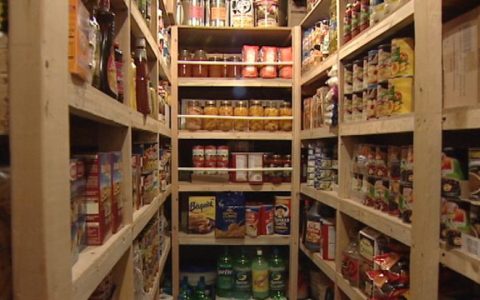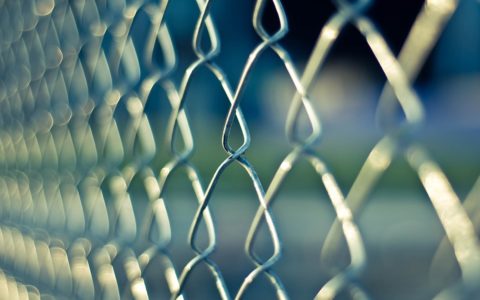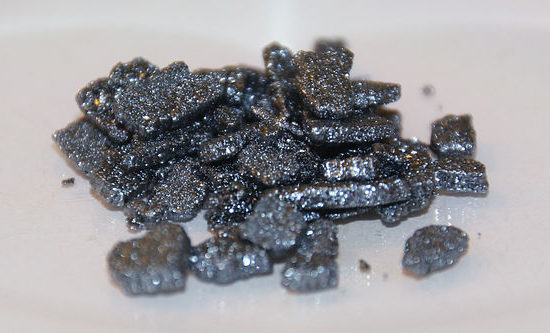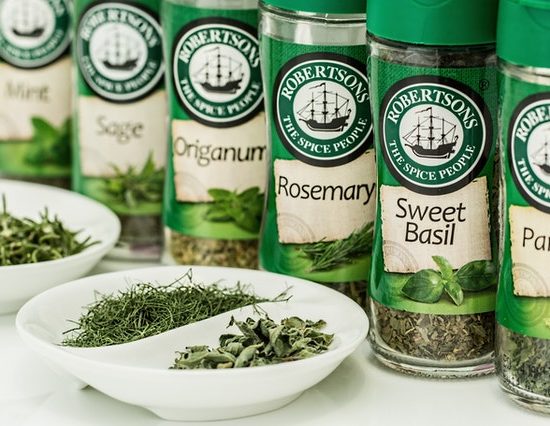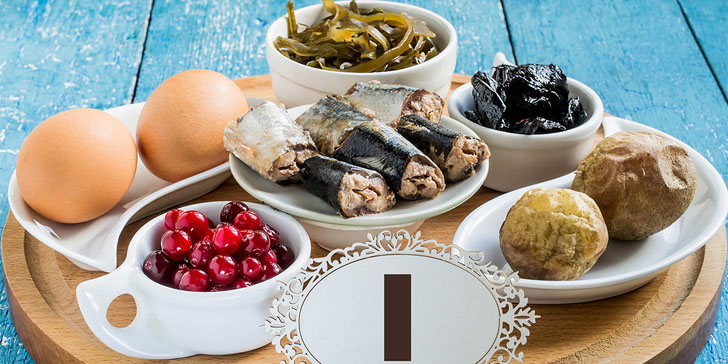
In a survival situation iodine is essential to have readily available, especially if there is a nuclear event of any type (see the section on Potassium Iodide supplementation for full details). Iodine is also essential to have due to its ability to disinfect water. After treating water with iodine you should let it stand for half an hour; this will allow enough time to kill off all the viruses and bacteria. If the water is cold (less than 68 degrees F) then you will have to give it four hours to be sure it is sterilized.
If you check the list of some of the most powerful nutrients to boost your immune system, Iodine stands out from the crowd.
Symptoms of hypothyroidism include fatigue, cold intolerance (you always feel cold), constipation, hair loss, bags under your eyes, and if severe enough, the thyroid gland will swell (goiter). A goiter is evident when looking at a person you will see a swollen area at the front base of their neck, below their larynx or Adam’s apple.
There are other more far-reaching effects of hypothyroidism including stopping ovulation and infertility in women, and increased risk of other cancers including prostate, endometrial, breast, and ovarian.
As a Prepper, iodine is one of the most useful items to have on hand; it is relatively inexpensive, and I also recommend you stockpile a good supply of potassium iodide for any radioactive exposure from a nuclear event as well as other forms of iodine such as Nascent Iodine for daily use, etc. Other sources of iodine are mostly from sea vegetables like kelp, seafood, and shellfish.
Note: The iodine content of iodized salt cannot be used as a source of iodine, since the amount you would need to raise the iodine levels in your blood would be fatal.
Symptoms of Iodine Deficiency
A deficiency of iodine can have serious effects on the body. The symptoms of its deficiency include the following:
- Depression and frustration
- Mental retardation
- Poor perception levels
- Goiter
- Abnormal weight gain
- Decreased fertility
- Coarse skin
- Chances of stillbirth in expectant mothers
- Constipation
- Fatigue
Iodine is an essential mineral you must get from your diet.
Here Are 9 Healthy Foods That Are Rich in Iodine
1. Seaweed
Seaweed is a good source of antioxidants, vitamins, and minerals. It’s also low in calories.
Seaweed is one of the best natural sources of iodine. However, the amount can vary significantly based on seaweed type, the region in which it grew and its preparation.
Three popular seaweed varieties include kombu kelp, wakame, and nori.
– Kombu Kelp
Kombu kelp is a brown seaweed sold dried or as a fine powder. It is often used to make a Japanese soup stock called dashi.
In a study that surveyed seaweed samples from various Asian countries for their iodine content, it was found that kombu kelp contains, by far, the highest amount of iodine compared to other species of seaweed.
Kombu kelp can contain up to 2,984 mcg of iodine per seaweed sheet (1 gram). This provides almost 2,000% of the recommended daily intake.
Excess iodine consumption is well-tolerated in the majority of people but could result in thyroid dysfunction for those who are susceptible.
– Wakame
Wakame is another type of brown seaweed that is slightly sweet in flavor. It is commonly used to make miso soup.
The amount of iodine in wakame seaweed depends on where it is grown. Wakame from Asia has higher amounts of iodine than wakame from Australia and New Zealand.
One study found that the average amount of iodine in wakame seaweed from various parts of the world was 66 mcg per gram or 44% of the daily recommended intake.
– Nori
Nori is a type of red seaweed. Unlike brown seaweeds, it has a much lower content of iodine.
Nori is the type of seaweed that is commonly used in sushi rolls.
The iodine content in nori varies between 16–43 mcg per gram or about 11–29% of the daily value.
Seaweed is an excellent source of iodine. However, the amount it contains depends on the species. Kombu kelp offers the highest amount of iodine, with some varieties containing nearly 2,000% of the daily value in one gram.
2. Cod
Cod is a versatile white fish that is delicate in texture and has a mild flavor.
It is relatively low in fat and calories but offers a wide variety of minerals and nutrients, including iodine.
According to the Icelandic Food Content Database, fish low in fat have the highest iodine amounts.
For instance, 3 ounces (85 grams) of cod has approximately 63–99 mcg, or 42–66% of the daily recommended amount.
The amount of iodine in cod can vary slightly depending on whether the fish was farm-raised or wild-caught, as well as the region where the fish was caught.
Higher amounts of iodine are found in fish low in fat compared to fatty fish. For instance, a lean fish like cod can provide up to 66% of the daily value.
3. Dairy
Dairy products are major sources of iodine, especially in American diets.
The amount of iodine in milk and dairy differs greatly based on the iodine content in the cattle feed and the use of iodine-containing disinfectants during milking.
A comprehensive study measured the iodine content in 18 different brands of milk sold in the Boston area. It found that all 18 brands had at least 88 mcg in 1 cup (8 ounces) of milk. Some brands even contained up to 168 mcg in one cup.
Based on these results, 1 cup of milk can provide 59–112% of the recommended daily amount of iodine.
Yogurt is also a good dairy source of iodine. One cup of plain yogurt provides approximately half of the daily recommended amount.
The amount of iodine in cheese varies depending on the type.
Cottage cheese is one of the best sources of iodine. One cup of cottage cheese provides 65 mcg, while one ounce of cheddar cheese provides about 12 mcg.
Although the exact amount of iodine in dairy products varies, milk, yogurt, and cheese are major sources of it in the American diet.
4. Iodized Salt
Currently, both iodized and unionized salt is sold in the United States.
The addition of iodine in table salt began in the US in the early 1920s to help decrease the occurrence of goiters, or swelling of the thyroid gland.
There is approximately 71 mcg of iodine in 1/4 teaspoon of iodized salt, which is 47% of the daily recommended intake. However, salt also contains sodium.
In the last few decades, iodine intake has decreased in the US. This is likely due to the push of major health organizations to restrict daily sodium intake to prevent or treat high blood pressure.
Nevertheless, salt only seems to raise blood pressure in salt-sensitive individuals, which is about 25% of the population.
Iodized and unionized salt are commonly sold in grocery stores. Consuming 1/2 teaspoon of iodized salt per day provides enough iodine to prevent a deficiency.
5. Shrimp
Shrimp is a low-calorie, protein-rich seafood that is an excellent source of iodine.
Additionally, shrimp provides key nutrients such as vitamin B12, selenium, and phosphorus.
Shrimp and other seafood are good sources of iodine because they absorb some of the iodine naturally present in seawater.
Three ounces of shrimp contain about 35 mcg of iodine or 23% of the daily recommended intake.
Shrimp is a good source of protein and many nutrients, including iodine. Three ounces of shrimp provide approximately 23% of the daily value.
6. Tuna
Tuna is also a low-calorie, high-protein, iodine-rich food. Furthermore, it is a good source of potassium, iron, and B vitamins.
Tuna is also a good source of omega-3 fatty acids, which may lower your risk of heart disease.
Fish higher in fat offer lower amounts of iodine. Since tuna is a fattier fish, the amount of iodine found in tuna is lower than in leaner fish varieties, such as cod.
However, tuna is still a relatively good source of iodine, as three ounces provide 17 mcg or about 11% of the recommended daily intake.
Tuna offers less iodine than lean fish but is still a relatively good source. Three ounces of tuna provide about 11% of the daily recommended amount.
7. Eggs
Eggs are also a good source of iodine.
For fewer than 100 calories, one whole egg provides a lean source of protein, healthy fats, and a wide assortment of vitamins and minerals.
However, the majority of these nutrients, including iodine, come from the yolk.
Egg yolks are a good source of iodine because it is added to chicken feed. Yet since the content of iodine in chicken feed can vary, the amount found in eggs can also fluctuate.
On average, one large egg contains 24 mcg of iodine or 16% of the daily value.
The majority of iodine in eggs is found in the yolk. On average, one large egg provides 16% of the daily recommended amount.
8. Prunes
Prunes are plums that have been dried.
Prunes are a good vegetarian or vegan source of iodine. Five dried prunes provide 13 mcg of iodine or about 9% of the daily value.
Prunes are commonly known for helping relieve constipation. This is because of their high content of fiber and sorbitol, a type of sugar alcohol.
Prunes are high in many vitamins and nutrients, including vitamin K, vitamin A, potassium, and iron.
Because of the nutrients prunes offer, they may help improve heart health, decrease the risk of colon cancer, and even help manage weight by reducing appetite.
Prunes are packed with vitamins and nutrients. Five dried prunes provide a good vegetarian source of iodine by meeting 9% of the daily value.
9. Lima Beans
Lima beans are commonly associated with the popular Native American dish succotash, which mixes lima beans and corn.
Lima beans are a good source of fiber, magnesium, and folate, making them a heart-healthy choice.
They are also a relatively good vegetarian or vegan source of iodine.
Due to the variation of iodine in soil, irrigation water, and fertilizers, the amount of iodine can vary in fruits and vegetables.
However, on average, one cup of cooked lima bean contains 16 mcg of iodine or 10% of the daily value.
Lima beans are high in fiber, magnesium, folate, and iodine. One cup of cooked lima beans provides about 10% of the daily value of iodine.
The Bottom Line
Iodine is an important mineral, though few food sources are rich in it.
This is why many people around the world are at risk of developing a deficiency.
The foods highest in iodine include seaweed, dairy, tuna, shrimp, and eggs. Additionally, most table salt has been iodized, providing an easy way to add iodine to your meals.
The foods listed in this article are not only some of the best sources of iodine, but they’re also very nutritious and easy to add to your daily routine.
Do you want more info like this? But all in one place? In case you’re a curious prepper, this information is from a book that can be used immediately to improve your health and expand your treatment options in many areas, even if there is never a crisis event for you and your loved ones. You can find more about this book here.
Other self-sufficiency and preparedness solutions recommended for you:
Put This Spice In Your Shoes To Fix Toenail Fungus
The vital self-sufficiency lessons our great grand-fathers left us
Knowledge to survive any medical crisis situation
Liberal’s hidden agenda: more than just your guns
Build yourself the only unlimited water source you’ll ever need













